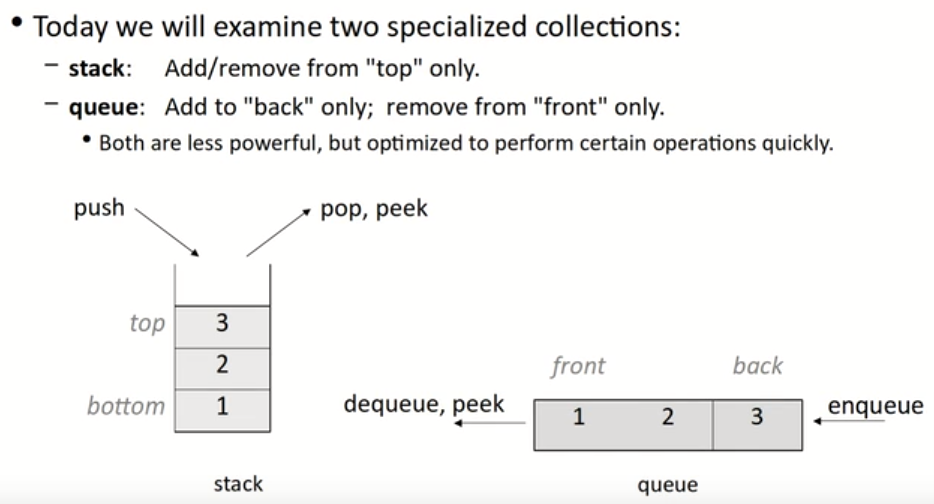1. Stacks and queues-SPL
今天我们将学习两个用于特定功能的集合(collections):
- 栈(
stack):仅从“top”位置添加/删除元素。 - 队列(
queue):仅从“end”位置添加元素,仅从“front”位置删除元素。 - 这两个集合虽然功能较少,但是针对特定操作进行了快速执行的优化。

2. Stacks
2.1 Concepts
栈:基于添加元素和以相反顺序检索它们的原则的集合。
- 后进先出(”LIFO”)
- 元素按插入顺序存储。我们不认为它们具有索引。
- 客户端只能添加/删除/检查最后添加的元素(即”顶部”)。
基本栈操作:
- push:将元素添加到顶部。
- pop:删除顶部元素。
- peek:查看顶部元素。
既然Vector拥有stack的所有功能,那我们为什么还需要stack呢,因为stack是一种用于某些专门用途的数据结构。
并且stack本身也比vector更加轻量,使用的内存更少,并且核心操作函数(peek()、pop()、push())的时间复杂度都是O(1),因此当用于某些特定用途时,stack明显更为合适。
2.2 Stacks in computer science
编程语言和编译器:
- 函数调用会被放置在一个栈上(调用=入栈,返回=出栈)
- 编译器使用栈来计算表达式
匹配相关的成对事物:
- 判断一个字符串是否为回文串
- 检查一个文件,查看其花括号 { } 是否匹配
- 将“中缀”表达式转换为前缀或后缀形式
复杂算法:
- 使用
backtracking在迷宫中进行搜索 - 许多程序使用
undo stack保存之前的操作记录
2.3 Stack-SPL
下图是SPL中的stack的大部分方法,当然我们也可以把stack打印到cout或者output stream中:

同样是介绍在SPL中使用的方法:
#include "stack.h" // SPL
stack<int> s; // {0} bottom -> top
s.push(42); // {42}
s.push(-3); // {42,-3}
s.push(17); // {42,-3,17}
cout << s.pop() << endl; // 17 (s is {42,-3})
cout << s.peek() << endl; // -3 (s is {42,-3})
cout << s.pop() << endl; // -3 (s is {42})
此外,如果你想在stack中像其他语言一样可以存储超类型object元素,yeah,但你为此必须得使用pointer(指针),我们会在接下来的几周里学到pointer;如果你想创建一个stack of objects,你可以像在其他语言中直接创建一个stack of objects,这意味着会复制每个object元素;你也可以创建一个stack of pointers,让pointer元素指向object对象所在的地址,这样就可以避免object对象的复制。
2.4 Stack limitations/idioms
不能用索引(S[i])的方式访问一个stack。每次只能从stack中弹出一个元素。
我们通常用while(!s.empty()){}的方式去遍历一个栈,每次访问一个元素,都会导致这个元素被删除(因为只有用s.pop()函数才能访问到下面的元素),所以如果不希望元素被删除,那么就不用stack。
2.5 Stack implementation
Stack内部一般是用Array或者Vector实现的。
bottom= index 0top= index (size - 1)
当然stack也可以用linked list实现。
top= front node
当Stack用Vector实现时,它的Insert操作的平均时间复杂度是O(1):在它需要扩容之前,都是O(1)是显而易见的;当进行第n+1次时,就需要扩容,显然这次操作是O(n),但是如果与前面的所有操作进行复杂度均摊,那么会发现每一次操作平均要2次移动,所以平均下来仍然是常数阶的时间复杂度,即O(1)。
3. Queues
队列:按照添加顺序检索元素。
- 先进先出(“FIFO”)
- 元素按照插入的顺序存储,但没有索引。
- 只能在队列的末尾添加元素,只能检查/删除队列的前端元素。
基本队列操作:
- 入队(enqueue):将一个元素添加到队列的末尾。
- 出队(dequeue):移除队列的第一个元素。
- 查看(peek):查看队列的第一个元素但不将其移除。
3.1 Queues in computer science
操作系统:
- 打印作业队列,用于发送到打印机的作业
- 程序/进程队列,用于运行待执行的程序/进程
- 网络数据包队列,用于发送数据包
编程:
- 模拟客户或顾客排队的队列
- 存储按顺序执行的计算的队列
现实世界的例子:
- 乘客在自动扶梯上或排队等候
- 在加油站(或生产线)等待的汽车
3.2 The Queue class-SPL
同样是介绍SPL库中的queue:

#include "queue.h" // SPL
Queue<int> q; // {} front -> back
q.enqueue(42); // {42}
q.enqueue(-3); // {42,-3}
q.enqueue(17); // {42,-3,17}
cout << q.dequeue() << endl; // 42 ( q is {-3,17})
cout << q.peek() << endl; // -3 ( q is {-3,17})
cout << q.dequeue() << endl; // -3 ( q is {17})
3.3 Queues idioms(常用遍历方式)
像stack一样,必须把元素从queue中取出来后才能访问他们:
// process ( and destroy ) an entire queue
while (!q.isEmpty()) {
do something with q.dequeue();
}
// 这种方法可以在最后保持queue原来样子的基础上遍历queue
// 即运行完q.dequeue()后,马上再运行一次q.enqueue()
// 这样运行完后queue还是原来的样子
// 但是不能直接去获取size的值,在程序开始前获取一次,使用到结束即可
int size = q.size();
for (int i = 0; i < size; i++) {
do something with q.dequeue();
(including possibly re-adding it to the queue)
}
3.4 Mixing stacks and queues
我们经常为了达成某种效果而把stacks和queues混在一起使用,如:逆序queue中的元素。
#include "stack.h" // SPL
#include "queue.h" // SPL
Queue<int> q;
q.enqueue(1);
q.enqueue(2);
q.enqueue(3); // {1,2,3}
Stack<int> s;
while (!q.isEmpty()) { // transfer queue to stack
s.push(q.dequeue()); // q={} s={1,2,3}
}
while (!s.isEmpty()) {
q.enqueue(s.pop()); // q={3,2,1} s={}
}
cout << q << endl; // {3,2,1}
3.5 deques(双向的queue)
双向queue,头部和尾部都可以进行enqueue或dequeue的操作。结合了stack和queue的功能,很少用。但是在SPL中仍然定义了它:#include "deque.h"。
双端队列(deque):一种双端开口的队列。
- 可以从任一端添加/删除元素。
- 组合了栈和队列的许多优点。
- 通常使用
linked list实现。
基本双端队列操作:
- 在前端/后端添加元素(enqueueFront/Back);
- 在前端/后端删除元素(dequeueFront/Back);
- 查看前端/后端元素(peekFront/Back)。

